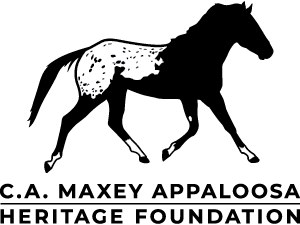History of the Appaloosa Horse
Horses were indigenous to the North American continent, living and evolving here until their sudden extinction 12,000 years ago. Horses were then re-introduced by European settlers, mainly the Spanish. From 1600 onward many dozens of native American tribes caught, tamed and rode horses, with many developing an elaborate horse culture. The Nez Perce tribe was unique among these in that they also bred their herd selectively, castrating inferior stallions and breeding for endurance, gait and color. The Nez Perce horses became well known after their glowing description in the logs of Lewis and Clark in 1806. The name Appaloosa derives from the valley of the Palouse river, where many thousands of the horses were observed by the early explorers and fur trappers. Their uncanny trail worthiness was put on magnificent display during the Nez Perce War of 1877, when around 2000 Appaloosa horses and about 700 Nez Perce outran and out-maneuvered the heavier, slower cavalry horses of General Howard and the US army over a winding trail more than 1,500 miles in length. The majority of the natives and their horses escaped into Canada along with Chief White Bird. However, the surrender of chief Joseph and his small encampment of women and children was of such stunning eloquence and fierce pride that history (and the politics of the time) chose to remember this as a US Army victory, when in fact it was a humiliating embarrassment.
The key characteristics of foundation Appaloosas reflect gait, color and endurance. The appaloosa gait is a four-beat amble or slow trot with a long forward reach and strong flexing of the pasterns to give a smooth, rocking horse gait. The endurance aspect is that this gait can be sustained for hours over many types of terrain, allowing the horse to cover up to twice the mileage per day as standard breeds. In keeping with this endurance ability is a relatively small, wiry, athletic build with the height at the withers of about 14.2 – 16 hands. The color pattern includes the full leopard and blanket patterns with prominent spots, and striped hooves, white sclera and freckling around the genitals and muzzle.
The Appaloosa horse is thus a breed distinct from all of the many others that now inhabit the Americas. After nearly being exterminated along with the native tribe that developed it, the Appaloosa heritage survived in bits and pockets in Canada and on ranches scattered around Oregon, Idaho and Montana. The inception of the Appaloosa Horse Club in 1938 reflected a widespread interest in the breed, but it was heavily influenced by non-native objectives for the breed, including racing and rodeo, showing at halter and stock horse use more suited to quarter horse breeding. The next 40 to 50 years saw a general expansion of the herd and popularity of the Appaloosa, but also the introduction of many non-breed characters such as heavy mane and tail, strong chest and heavy muscling, inappropriate small hooves with respect to body size, and loss of strong coloring, replacing it with simple snowflake speckling or roaning.
It is the objective of the C.A. Maxey Appaloosa Heritage Foundation first and foremost to provide teaching and outreach opportunities at all levels, but especially to youthful audiences. We want to explain both the breeding and the importance of this special horse in the history of the Nez Perce tribe. It is also the objective of the Foundation to selectively breed and preserve the true foundation Appaloosa, recovering and promoting those traits that the natives valued themselves. The first 100 years following the surrender of Chief Joseph and the confinement of the Nez Perce to reservations has not made this an easy task. First, under the mismanagement of the Army and Bureau of Indian Affairs, the native horse gene pool was polluted by the introduction of heavy draft horse characteristics. Then under the sporting attitude of the Appaloosa Horse Club, quarter horse, Arabian and other non-native blood was also intermixed with the foundation Appaloosa. Our objective, already realized since the early 1960s and with every intention of spanning over many dozens of generations, is to carefully, selectively breed back to the same uniquely American horse first seen by western eyes more than 200 years ago.
